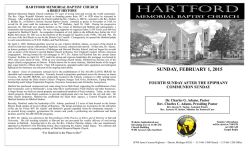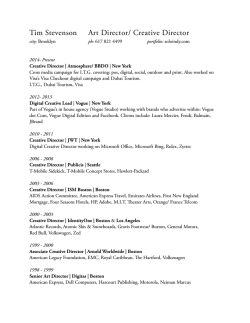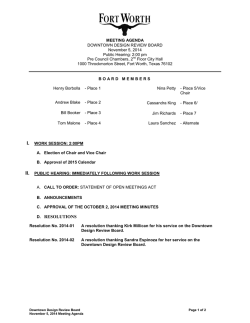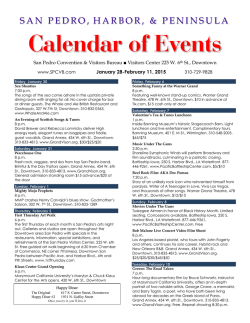
Knowing how we got here helps plan for tomorrow Some thoughts
Knowing how we got here helps plan for tomorrow Some thoughts from Bob Killian after 30 days of discussions with a lot of people When I was born, Hartford was home to over 177,000 people and was the core of an urbanized metropolitan area1 which the census reported at around 300,000. Thus, Hartford was home in 1950 to about half of the region’s population. All the region’s hospitals, most banks, professional offices, insurance companies and a healthy percentage of the manufacturing jobs (save for East Hartford’s Pratt and Whitney) were sited here. Four major department stores (G. Fox, Brown-Thomson, Wise & Smith and Sage Allen) were situated within two Main Street blocks and were supplemented by numerous specialty shops, three five and dimes, bakeries, drug stores and three grocery markets—the precursors of the 50 thousand plus square foot grocery stores of today. We were then— and remain today—the cultural center of the region with six downtown movie screens, two stages, the Bushnell and State, each seating around three thousand patrons, and the Wadsworth Atheneum, truly one of America’s great art museums. There were many other assets we had yet to realize: The Mark Twain and Harriet Beecher Stowe Houses, one a branch library; the other a private residence, both soon to be threatened with demolition. People took pride in their neighborhood schools; insurance and manufacturing jobs were both expanding; and our economy was rapidly absorbing the returning Vets and the promise of the Eisenhower Highway program had us enthusiastically planning I-84 and I91, oblivious to some of their unintended consequence. Home construction in Hartford— mostly small, single family with either a one car garage or no garage—virtually eliminated available lots in the south and north end. During the 50’s, streets abutting Asylum Avenue saw a transformation as three story apartment buildings with studio and one bedroom apartments replacing 1-3 unit buildings to absorb the influx of insurance and healthcare workers, mostly single, coming to our city. They came downtown on busses, for 15 cents. There was little provision for parking in their neighborhood. There was housing in downtown—mostly in the Capitol Avenue and Front Street areas. But plans were underway to demolish Front Street, Hartford’s “Little Italy” as another sacrifice to the vision of New England’s second most vital banking/financial center. In short, we were a self-contained city with little reason to venture to the suburbs unless we wanted to buy a dozen fresh eggs or an ear of corn. West Hartford was 1 Census Data is a little confusing. Census figures are historically reported by county; more recently, the Feds utilize a New England oriented compilation that seeks to address the fact that our emphasis on towns (and our abolition of County government) as well as our commuter patterns make historical counties an almost meaningless statistic. The new formula includes parts of Middlesex county and Tolland County as part of Greater Hartford. I am using county here because it reflects in my opinion a truer picture of the region’s political reality. 1 developed as residential almost to Trout Brook and had manufacturing in the areas abutting Hartford from Park Street through Elmwood. East Hartford had Pratt and Whitney and residential but was half West Hartford’s size. Remember this: during this period Hartford still had a working dairy farm on the site now known as the University of Hartford and a surviving pig farm on the banks of the Park River (the last in a number of such farms which gave the Park its “nom de plume” the Hog River to people who lived down river from it.) Every one of our suburban neighbors had multiple farms and areas we know today as Bishop’s Corner and West Farms Mall, which were among the areas that many of us remember as fields of corn. Things rapidly changed. Our farms bit the dust in 1957. Suburban farms diminished starting at the same time, but there are still a few remaining. Housing exploded in the suburbs and their growth was huge. Whole neighborhoods were erected in every one of our neighbors—including East Hartford, the only “suburb” with strong urban characteristics. By 1980, shortly before I became Probate Judge, Hartford’s population had decreased to 136,000, but Hartford County’s population had exploded to 810,000. That means Hartford was 16.5% of the County’s population. That’s a trend which continues. By 2013, Hartford County was pushing a million people, while Hartford’s population was 125,000 or about 13% of the total. Politicians seem to focus on how many people live here. I believe 125-130,000 may actually be a “right sizing” for Hartford. We don’t have land for the type of housing favored by most people, the single family home with a two or more car garage. The cost of building multi story residential buildings is too high, desirable footprints too few, and, when all of this is coupled with our high taxes and the city’s poor fiscal prognosis, reality and doubt is likely to discourage any new development not heavily subsidized by government investment or tax abatement. A positive exception: creation of a number of downtown apartments through the conversion of excess commercial properties to residential apartments and condos. These new units will be for relatively well- heeled young people who will choose downtown residences to enjoy our urban oasis until marriage or children lure them away, hopefully to our west end. Retirees are also a strong market for downtown life. That could bring the number from the approximately one thousand who live there now to two thousand. It will also help stop the precipitous decline in commercial property values that has downtown buildings selling for a fraction of their building cost. These are buildings which pay taxes now. After conversion they will continue to pay taxes. But the amount they pay will only grow if the downward spiral of center city building values turns around. Remember, we are phasing out our residential/commercial property tax differential, have taken buildings off the tax rolls by sale to the state and nonprofits; and now plan on spending more to attract development than the projects will generate in taxes for decades. Our office buildings also employ hundreds of Hartford 2 residents. Truth be told, however, they employ thousands more of our suburban neighbors who come here daily, mostly by car. This great office center is one of the many services Hartford provides the region. The late, great Hubert Humphrey once said the measure of a nation’s greatness is not its military might or gross national product but how it treats those at the dawn of life, our children; those at the end of life, our seniors; and those who live in life’s shadows: our mentally ill, homeless, developmentally disabled, aged and infirm. If we applied that test to our city, Hartford passes with flying colors. As a probate judge I deal with families in distress. Hartford is one of 54 probate districts in Connecticut. Most consist of several municipalities, but our court serves only the city of Hartford. Even so it handles 22% of all the conservatorships in the state; 30% of the mental health commitments, over 50% of the alcohol and drug commitments, and 21% of the removals of children from abusive parents. The U.S. Census confirms that a disproportionately high number of the region’s seriously mentally ill, physically and mentally disabled, immigrants, homeless, unemployed and, most significantly, poor live here. Our region is a great place to live. It offers most of its residents a quality of life second to none. Hartford makes it an urbanized region and offers cultural amenities, jobs, recreational opportunities from circuses to sports to home shows and flower shows, medical resources and a magnificent riverfront. The region reads with pride news reports that Greater Hartford is among the nation’s wealthiest regions. But to many of the people who live here, they reside only in the shadow of wealth. Our success as a region is readily acknowledged, but the fact that Hartford is second only to Brownsville, Texas as the nation’s poorest city over 100,000 people seems too often forgotten. 34% of our residents live in poverty. Per capita income here is under $17,000. That is less than half the almost $35,000 of the rest of the region. 4% of our residents live in owner occupied housing versus 66% in the region. Hartford serves 7,178 people per square mile compared to 1,216 people per square mile in the region. 2 Those the census calls minorities are the majority in our city; 86% are Black, Hispanic, or Asian, which compares to 32% in the region3. We do the job of caring for those who are the regions most challenged citizens for virtually all our neighboring towns and as a result, we’re broke. We’ve used up the gimmicks 2 Half of our 17.5% reported square miles are dedicated to park lands, government facilities, charitable institutions, colleges, schools, churches and the Connecticut River bed. Take out of the mix the tax exempt or partially taxed land, and you realize that rather than 7,178 people per square mile we have an amazing 15625 people living on buildable land. That’s what is also known as our taxable grand list. 3 Remember all region numbers are inclusive of the Hartford numbers! 3 available to us to pay our bills. Our tax-raised revenues fall 40-50 million dollars shy of meeting our annual obligations. Over the years, we have sought state permission to tax commercial property at a higher rate than residential. That has imposed an intolerable burden on commercial property. We have received greater PILOT (Payment In Lieu Of Taxes) from the state for the tax exempt property for which it makes a partial tax contribution4; and we have sold our civic center and our parking garage to the state. There’s talk of selling our parking meters to private enterprise. A regionalization of many schools, magnet, charter and special, with the state providing generous support for new buildings and various components of the cost of providing an education, has resulted in a shift of this burden and, I believe, the first glimmer of a quality turnaround than we have seen in years. But it has also seen an elimination of the traditional neighborhood schools and the resultant loss of a sense of community and often way too much time on a bus for our kids. We have deferred maintenance on schools, city hall, flood control systems, parks, roads, sidewalks, and equipment. We have eliminated programs for elements of our population, including grandparents, the elderly and children that defy our obligation to our residents. We are warned that our pension funds will be jeopardized if we don’t realistically fund them given the growth in city payrolls, the generosity of our plans and the greater longevity we all are enjoying. We have used funds secured for certain important uses and diverted them to other purposes. When we sell capital assets, we use them to pay current expenses. We have been saved by the effectiveness of our legislative leaders and the Governor, who have been historically generous in dealing with Hartford’s fiscal mess. But for the state’s generosity, our crippling mill rate would be almost 50% higher. I think the generosity is attributable to several key facts: 4 They recognize the role Hartford plays as the urban core of a wealthy region. They understand that in addition to being the cultural, educational, financial, business, health and historical center of our region, we are the place that houses and cares for the poor and underprivileged in our region. They know that geography and charitable/governmental property tax exemptions rob us of our ability to support our city. We have few middle class neighborhoods and even fewer rich people’s houses. We have a vibrant central business district, magnificent albeit tax exempt hospitals, churches, and, wonderful parks. We also have thousands of poor and disadvantaged residents who depend on government for their lives. There is, in fact, a sort of de facto regionalization in which people outside of Hartford, through payments channeled through the state, meet the unusually high costs of operating their urban core. School programs, created in response to Horton Pilot is a godsend to Hartford even though it pays only 30% of what a non-tax exempt property owner would pay. 4 v. Meskill, have also contributed to Hartford’s economic well-being by adopting a regionalized approach that has improved our school quality while moderating our city’s cost. Governor Malloy, as a former mayor, is keenly aware of the importance of healthy cities in a healthy region or state. He deserves our thanks. So are there areas where Hartford has failed to acquit itself of its responsibilities? I fear we are not good managers of the resources we have, spending our assets on ideas with curb appeal but no long term advantage to our city’s fiscal morass. I fear we have also fallen into a trap, not unique to ourselves. We seem to believe that money derived from bonds is free and that we can spend ourselves out of a fiscal mess. As a government, we are all too willing to kick the fiscal can down the road and leave the due date for someone else’s watch. We are not the federal government. We don’t control the money presses. We are not even the state which backs its full faith and credit with income taxes, sales taxes, gas taxes, gross receipt taxes, possibly tolls, estate taxes, admission taxes and a number of other revenue sources. We are Hartford. We have a finite amount of land, already heavily committed to a variety of uses and a downtown neighborhood that has overpaid its property taxes. A confiscatory tax burden, combined with the overbuilding of commercial property and retrenchment and relocation by some of our core businesses has driven down commercial property’s value. Virtually the only developers we have seen active recently are those who were able to buy commercial properties at very distressed prices or those who are selling their property to the state or with the promise of significant municipal conversion contribution. The state buys property on Constitution Plaza or Columbus Boulevard or Capitol Avenue and it takes vacant properties off the vacancy rate. That’s good. But it also takes the property off the tax rolls. Right now, this flow of vacant buildings to utilized tax exempt status is an important first step in rehabilitating our downtown. Housing conversion also reduces commercial vacancies and places new bodies on Main Street which will help revitalize downtown. New bodies should increase retail possibilities here. Maybe a few restaurants can stay open for Sunday brunch and dinner. But we mustn’t engage in magical thinking: Even three or four thousand downtown residents—and that number is years off—won’t bring back department stores, and would be unlikely able to sustain a full grocery store. But maybe a good market could be here. That’s as long as a non-resident could park and shop there on the way home. These downtown residents are still going to shop at Blueback or West Farms or Evergreen. (All are car friendly and able to draw on the entire region’s million plus residents.) They’ll still have doctors with offices in Farmington or want to go to the 5 New Britain Museum of American Art or bring a kid to the Hartt School for a music lesson. Upscale residents in this area, like their middle class neighbors, will unlikely abandon their cars for busses. At best, a young couple might have one car instead of two. Planners can’t engage in magical thinking. Development that doesn’t plan for the auto is doomed to fail. Development predicated upon the belief that adding three or even four thousand new downtown neighbors will solve the problems of the remaining 125,000 residents is foolhardy and unrealistic. IQuilt advocates better make sure the planners have properly assessed the cost of relocating a street and then decide if the real cost of that amenity which will not make way for any new development in the Gold Street area and seems to be disfavored by the residents who live there, is worth the cost. Development of the Bushnell Memorial area should carefully assess whether a reduction in convenient free parking near the Bushnell might not damage that venerable, if vitally important, community resource. I am unaware of large numbers of people who want to walk from the Capitol to the Travelers. IQuilt may cost the city millions and benefits few if any. Many of us have talked for years about the importance of bridging the I-84 chasm. Some of us called on state leaders to use the convention center, science center and hotel concept to do this. A convention center, hotel and science center would have done the trick. (It could have really bridged I-84.) It would have made Hartford a truly compact walking town. It could have put our hotels proximate to the convention center and the civic center, and made the convention center viable, in light of the decision to build a convention center and cut back by almost half on the major hotels, resulting in a building larger than the hotel rooms supporting it. Of course it wouldn’t have required the demolition of existing commercial space that was contributing in excess of two million dollars to the city’s coffers and now contributes nothing. The funds utilized for the “entertainment district’ could have utilized existing space—the exhibition hall in the convention center as a movie theater; new restaurants in long vacant space in Hartford 21; shops on Hartford’s elegant but underutilized Pratt Street and the existing bars and restaurants which did not deserve to be left out of this plan. By building on Columbus Boulevard we abandoned land ripe for additional commercial and residential development. Why did we spend millions on a beautiful riverfront and then close a large part of it off to the city again with a windowless convention center? The baseball stadium is an insult to Hartford taxpayers and shows a high level of ineptitude on the part of city leaders. I do not believe a baseball stadium will incline anyone to build or live here. I don’t believe the proponents, in spite of the thousands they spent on planners, have the slightest idea what the true cost of the stadium will be. I don’t believe we should commit our limited treasure to a stadium that will create few meaningful jobs, will inure to 6 the benefit of a team owner who is unwilling to put any skin in the game or a few parking lot owners. The decision to bid against New Britain flies in the face of regional planning and regional comity and is the political equivalent of poking a finger in a good neighbor’s eye. The insistence on this component of the plan is ludicrous. The price tag—even the announced cost which is increasingly in doubt--is proof of the fundamental management limitations of our leaders. Future generations will be saddled with this white elephant and its recurring annual cost. Remember, it may not even have a baseball team to play in it. Are the politicos assuming that the state will take this off our hand in future years? It seems almost daily we learn of another mess-up by our city fathers. The Soccer plan for Colt Park is rife with problems and is being built for another tenant of questionable viability at a cost that is already escalating. As I meet with people in our city, I met few who are cheerleaders for any of these projects. They live in neighborhoods with issues of creeping blight. Their road maintenance is abysmal; their tax rate stifling. Plans and proposals fall far short of serving their concerns and needs. When we decide to float bonds for city projects, we must make sure it will create a tide that raises all city stakeholder’s boats. 7
© Copyright 2024



